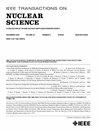The Influence of Electronic Stopping on Displacement Damage and the Correction of Effective NIEL Model
IF 1.9
3区 工程技术
Q3 ENGINEERING, ELECTRICAL & ELECTRONIC
引用次数: 0
Abstract
In this article, we utilized molecular dynamics (MD) simulation techniques to study the cascade collision process of the primary knock-on atom (PKA) in silicon (Si), with incident energy ranging from 0.1 to 20 keV. Based on the electron–phonon MD (EPH) model, we investigated the influence of electronic stopping power on defect evolution. The research results indicate that the presence of electron stopping may not only inhibit the formation of defects, leading to a reduction in the number of defects induced by low-energy particles, but also hinder the recombination process of defects, increasing the number of stable defects after high-energy particle irradiation of materials. Based on the Norgett, Robinson, and Torrens (NRT) model and MD simulations, we applied a correction to the effective non-ionizing energy loss (NIEL) model by introducing the athermal recombination corrected (ARC) model. By controlling the physical processes of electron stopping, we have discussed the role of electron stopping in effective NIEL. The numerical calculation results show that our model exhibits a high degree of similarity in trends with traditional analytical methods. In the case of particle incidence at the kiloelectronvolt level, the effect of electron stopping on the calculation of NIEL is particularly significant. Furthermore, we have also found that a higher displacement threshold parameter setting can increase the magnitude of the NIEL values.电子停车对位移损伤的影响及有效NIEL模型的修正
在本文中,我们利用分子动力学(MD)模拟技术研究了入射能量在0.1 ~ 20kev范围内的初级撞击原子(PKA)在硅(Si)中的级联碰撞过程。基于电子-声子MD (EPH)模型,研究了电子停止功率对缺陷演化的影响。研究结果表明,电子停止的存在不仅可以抑制缺陷的形成,导致低能粒子诱导缺陷的数量减少,而且可以阻碍缺陷的重组过程,增加材料在高能粒子辐照后稳定缺陷的数量。基于Norgett, Robinson, and Torrens (NRT)模型和MD模拟,我们引入了非热复合校正(ARC)模型,对有效非电离能量损失(NIEL)模型进行了修正。通过控制电子停止的物理过程,讨论了电子停止在有效NIEL中的作用。数值计算结果表明,该模型与传统的分析方法在趋势上具有高度的相似性。在粒子入射于千电子伏水平的情况下,电子停止对NIEL计算的影响尤为显著。此外,我们还发现,较高的位移阈值参数设置可以增加NIEL值的大小。
本文章由计算机程序翻译,如有差异,请以英文原文为准。
求助全文
约1分钟内获得全文
求助全文
来源期刊

IEEE Transactions on Nuclear Science
工程技术-工程:电子与电气
CiteScore
3.70
自引率
27.80%
发文量
314
审稿时长
6.2 months
期刊介绍:
The IEEE Transactions on Nuclear Science is a publication of the IEEE Nuclear and Plasma Sciences Society. It is viewed as the primary source of technical information in many of the areas it covers. As judged by JCR impact factor, TNS consistently ranks in the top five journals in the category of Nuclear Science & Technology. It has one of the higher immediacy indices, indicating that the information it publishes is viewed as timely, and has a relatively long citation half-life, indicating that the published information also is viewed as valuable for a number of years.
The IEEE Transactions on Nuclear Science is published bimonthly. Its scope includes all aspects of the theory and application of nuclear science and engineering. It focuses on instrumentation for the detection and measurement of ionizing radiation; particle accelerators and their controls; nuclear medicine and its application; effects of radiation on materials, components, and systems; reactor instrumentation and controls; and measurement of radiation in space.
 求助内容:
求助内容: 应助结果提醒方式:
应助结果提醒方式:


